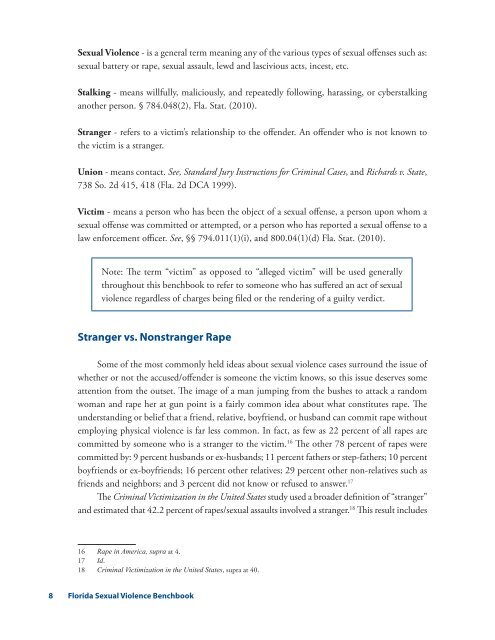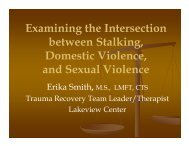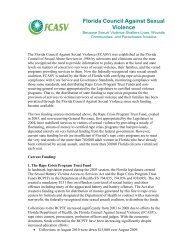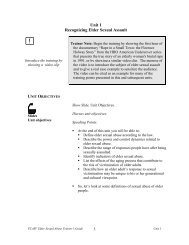Florida Sexual Violence Benchbook - Florida Council Against ...
Florida Sexual Violence Benchbook - Florida Council Against ...
Florida Sexual Violence Benchbook - Florida Council Against ...
Create successful ePaper yourself
Turn your PDF publications into a flip-book with our unique Google optimized e-Paper software.
<strong>Sexual</strong> <strong>Violence</strong> - is a general term meaning any of the various types of sexual offenses such as:<br />
sexual battery or rape, sexual assault, lewd and lascivious acts, incest, etc.<br />
Stalking - means willfully, maliciously, and repeatedly following, harassing, or cyberstalking<br />
another person. § 784.048(2), Fla. Stat. (2010).<br />
Stranger - refers to a victim’s relationship to the offender. An offender who is not known to<br />
the victim is a stranger.<br />
Union - means contact. See, Standard Jury Instructions for Criminal Cases, and Richards v. State,<br />
738 So. 2d 415, 418 (Fla. 2d DCA 1999).<br />
Victim - means a person who has been the object of a sexual offense, a person upon whom a<br />
sexual offense was committed or attempted, or a person who has reported a sexual offense to a<br />
law enforcement officer. See, §§ 794.011(1)(i), and 800.04(1)(d) Fla. Stat. (2010).<br />
Note: The term “victim” as opposed to “alleged victim” will be used generally<br />
throughout this benchbook to refer to someone who has suffered an act of sexual<br />
violence regardless of charges being filed or the rendering of a guilty verdict.<br />
Stranger vs. Nonstranger Rape<br />
Some of the most commonly held ideas about sexual violence cases surround the issue of<br />
whether or not the accused/offender is someone the victim knows, so this issue deserves some<br />
attention from the outset. The image of a man jumping from the bushes to attack a random<br />
woman and rape her at gun point is a fairly common idea about what constitutes rape. The<br />
understanding or belief that a friend, relative, boyfriend, or husband can commit rape without<br />
employing physical violence is far less common. In fact, as few as 22 percent of all rapes are<br />
committed by someone who is a stranger to the victim. 16 The other 78 percent of rapes were<br />
committed by: 9 percent husbands or ex-husbands; 11 percent fathers or step-fathers; 10 percent<br />
boyfriends or ex-boyfriends; 16 percent other relatives; 29 percent other non-relatives such as<br />
friends and neighbors; and 3 percent did not know or refused to answer. 17<br />
The Criminal Victimization in the United States study used a broader definition of “stranger”<br />
and estimated that 42.2 percent of rapes/sexual assaults involved a stranger. 18 This result includes<br />
16 Rape in America, supra at 4.<br />
17 Id.<br />
18 Criminal Victimization in the United States, supra at 40.<br />
8 <strong>Florida</strong> <strong>Sexual</strong> <strong>Violence</strong> <strong>Benchbook</strong>

















